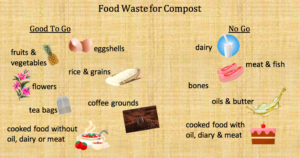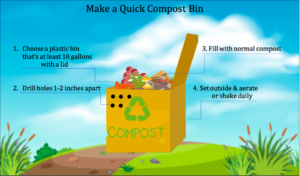To successfully compost, four things are needed: carbon (browns), nitrogen (greens), air, and water. GREENS are wet materials high in nitrogen. BROWNS are dry materials high in carbon.

To keep your compost bin from becoming a nuisance by limiting odor, litter, or dust, it is important to only add the “right” things to your compost bin. Items that should never be added to an at-home compost bin or pile include:
- Meat and fish
- Bones
- Dairy products
- Grease
- Prepared foods
- Dog, cat or bird feces
- Plywood or treated wood sawdust
- Diseased plants
- Weeds that went to seed
- Invasive plants
- Products/containers that say they are compostable or biodegradable
Avoid putting products/containers that say they are compostable in your backyard compost, even if they say that they are backyard compostable. In actuality these products are only compostable in commercial composting as your backyard compost doesn’t get warm enough to properly breakdown these materials.

In order to maintain the proper composting environment for the microorganisms living and working in your compost pile, it is necessary to keep five important factors in mind when tending to your pile. The reason is that microorganisms live in the compost pile and require the right amount of food, water, and air to thrive. A byproduct of their work is heat energy. A healthy environment for these critters results in an increase of their population which means an increase of heat in your compost heap. Your pile could reach 131 degrees Fahrenheit or more! The most efficient bacteria at decomposing are those who prefer higher temperatures. So, the hotter your pile the faster you get finished compost!
Get Started Composting:
- Locate the pile at least 2 feet from any building, fence, or other structure.
- Make sure you have both greens and browns, as described above
- Build the pile
- Start with sticks and branches, to provide some aeration at the base
- Alternate layers of green and brown
- End with a brown layer
- Turn the pile as needed to ensure aeration. Composting requires proper distribution of air, moisture, and heat

